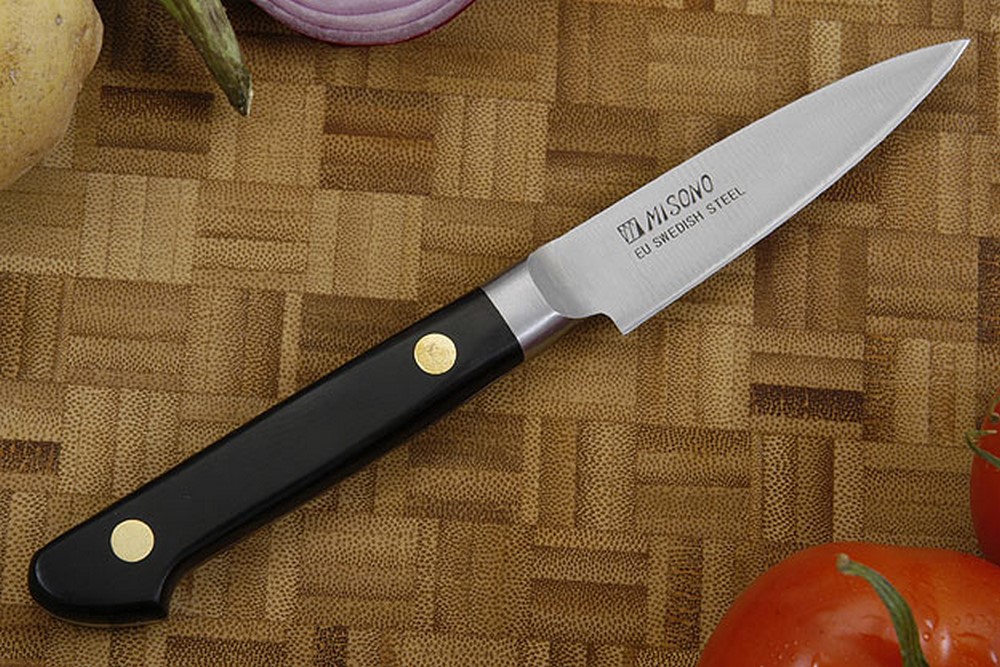I have been looking for a Japanese carbon steel paring knife and finally found one that I really like. The knife is made by a company called Masamoto and it is their KS model. The KS stands for kasumi, which means foggy or hazy, and refers to the way the blade is forged from multiple layers of steel.
This results in a very strong and sharp blade that can hold an edge well.
There’s something about a Japanese carbon steel paring knife that just feels right in the hand. It’s the perfect size for delicate slicing and peeling, and the blade is so razor sharp that it makes quick work of any prep work.
But what really sets this knife apart from other paring knives is the fact that it’s made from carbon steel.
This gives the blade an incredible edge retention, meaning that it will stay sharp longer than your average kitchen knife. And because it’s made from carbon steel, it’s also very easy to sharpen when needed.
If you’re looking for a top quality paring knife that will make light work of any prep task, then look no further than a Japanese carbon steel paring knife.
You won’t be disappointed!
Japanese Paring Knife Name
When it comes to kitchen knives, there is a lot of debate over which type is the best. However, when it comes to paring knives, there is one clear winner and that is the Japanese Paring Knife.
This knife is incredibly sharp and can handle any kind of cutting task you throw at it.
Whether you need to peel an apple or slice a tomato, this knife will get the job done quickly and easily.
The Japanese Paring Knife also has a comfortable grip that makes it easy to hold onto while you are working. This is important because you don’t want your hand slipping while you are trying to cut something.
If you are looking for a high-quality paring knife, then look no further than the Japanese Paring Knife. It will make your life in the kitchen much easier and help you create beautiful meals.
Best Japanese Paring Knife
A Japanese paring knife is a versatile and essential tool in any kitchen. It is perfect for precision tasks like peeling and slicing fruits and vegetables. Japanese paring knives are known for their sharpness, making them ideal for working with delicate ingredients.
There are many different types of Japanese paring knives available on the market, so it is important to choose one that best suits your needs. Here are some factors to consider when choosing a Japanese paring knife:
Blade Material: The blade of a Japanese paring knife is usually made from carbon steel or stainless steel.
Carbon steel blades are extremely sharp but can rust if not properly cared for. Stainless steel blades require less maintenance but are not as sharp as carbon steel blades.
Blade Shape:Japanese paring knives typically have a straight or slightly curved blade.
The shape of the blade affects how the knife feels in your hand and how well it performs certain tasks. For example, a straight-edged blade is great for slicing fruits and vegetables, while a slightly curved blade is better suited for peeling applications.
Handle Material: The handle of a Japanese paring knife can be made from wood, plastic, or metal.
Wood handles provide good grip and comfort but can become stained over time. Plastic handles are durable and easy to clean but may not be as comfortable to hold as wood or metal handles. Metal handles offer the best durability but can be slippery to hold if your hands are wet or oily.
Japanese Petty Knife
A Japanese petty knife is a versatile and handy tool that every kitchen should have. It’s perfect for slicing vegetables, fruits and meats. It can also be used for peeling and chopping.
The blade is usually between 2-4 inches long, making it the ideal size for smaller jobs in the kitchen.
If you’re looking for a quality Japanese petty knife, make sure to look for one with a high carbon steel blade. This will ensure that your knife stays sharp longer and is less likely to rust or corrode over time.
Many of these knives also come with a wooden handle which makes them more comfortable to grip and use.
So if you’re looking for a versatile and handy kitchen knife, consider getting yourself a Japanese petty knife!
Japanese Knife
Japanese knives are some of the sharpest and most durable knives in the world. They are made with high-quality steel that is designed to withstand a lot of wear and tear. Japanese knives also have a very fine edge, which makes them ideal for slicing through tough ingredients like meats and vegetables.
If you’re looking for a knife that will help you prep meals quickly and efficiently, then a Japanese knife is definitely the way to go. In this blog post, we’ll take a closer look at what makes these knives so special and why they’re worth the investment.
First, let’s talk about the construction of Japanese knives.
As we mentioned before, they are made with high-quality steel that can withstand a lot of wear and tear. The blades are also heat-treated to make them even stronger and more durable. Additionally, Japanese knives often have a thinner blade than other types of knives, which makes them great for slicing through delicate ingredients without damaging them.
Another reason why Japanese knives are so popular is because of their incredible sharpness. Thanks to the fine edge on these blades, you’ll be able to slice through ingredients with ease – no matter how tough they may be. And if you ever need to re-sharpen your knife, it’s easy to do so with just a few simple strokes on a honing rod or diamond stone .
Finally, we wanted to mention that Japanese knives come in a wide variety of styles and sizes – so there’s definitely one out there that’s perfect for your needs. Whether you’re looking for a chef’s knife , paring knife , or even a Santoku knife , you can find it in Japanesestyle . Plus, if you have any specific preferences when it comes to handle materials or blade shapes , there’s sure to be a Japanese knife that fits the bill perfectly.
Shun Paring Knife
A Shun paring knife is a great addition to any kitchen. It’s small size is perfect for peeling and slicing fruits and vegetables. The blade is made of high-carbon steel, which makes it extremely sharp.
The handle is ergonomically designed for comfort and balance. This knife is also dishwasher safe.
Japanese Chef Knife
A Japanese chef knife is a versatile tool that can be used for a variety of tasks in the kitchen. Whether you’re slicing, dicing, or chopping, a Japanese chef knife can help you get the job done quickly and efficiently.
There are a few things to keep in mind when choosing a Japanese chef knife.
First, consider the size of the blade. A larger blade will be able to tackle more challenging tasks, while a smaller blade will be better suited for delicate work. Second, think about the handle.
You’ll want to choose a comfortable handle that fits securely in your hand. Finally, consider the price. While higher-priced knives may offer better quality, there are plenty of great options available at lower price points as well.
Once you’ve found the perfect Japanese chef knife, it’s time to put it to use! These knives are incredibly versatile and can be used for everything from chopping vegetables to slicing meat. So whether you’re an experienced cook or just starting out in the kitchen, a Japanese chef knife is sure to become one of your go-to tools.

Credit: www.epicedge.com
What is a Japanese Carbon Steel Paring Knife
A Japanese carbon steel paring knife is a small, sharp knife that is used for peeling and slicing fruits and vegetables. It has a short, straight blade that is easy to control, making it ideal for intricate work. The high carbon content of the steel makes the blade extremely hard, which helps it retain its edge longer than other types of knives.
What are the Benefits of Using a Japanese Carbon Steel Paring Knife
There are many benefits of using a Japanese carbon steel paring knife. Perhaps the most obvious benefit is that it is extremely sharp. A Japanese carbon steel paring knife can easily slice through tough vegetables and fruits with ease.
This type of knife is also known for its durability – it will keep its edge for a long time if properly cared for.
Another great benefit of using a Japanese carbon steel paring knife is that it is very easy to sharpen. If you find that your knife has become dull, simply use a honing rod or sharpening stone to quickly restore its edge.
Additionally, because the blade is made from carbon steel, it will resist rust and corrosion better than other types of knives.
If you are looking for a high-quality, durable and sharp paring knife, then a Japanese carbon steel option would be an excellent choice!
How Should I Care for My Japanese Carbon Steel Paring Knife
Your Japanese carbon steel paring knife is a versatile and powerful tool in your kitchen, but it does require some special care to keep it in top condition. Here are some tips on how to care for your Japanese carbon steel paring knife:
1. Keep it clean and dry.
After each use, wash your knife with warm water and mild soap. Then, dry it thoroughly with a soft cloth or air-dry it before storing.
2. Avoid rust.
Rust can damage the blade of your knife, so be sure to keep it clean and dry at all times. If you notice any rust spots, immediately remove them with a soft cloth or fine sandpaper.
3. Store properly.
When not in use, store your knife in a dry, safe place where it will not come into contact with other metal objects that could cause corrosion or damage the blade. A wooden knife block or sheath is ideal for storing your Japanese carbon steel paring knife safely when not in use.
How Do I Sharpen My Japanese Carbon Steel Paring Knife
Assuming you are looking for a traditional Japanese water stone to sharpen your knife:
The most important thing when sharpening any knife is to maintain a consistent angle. With a paring knife this is especially important because of how often it is used.
A good rule of thumb is to hold the blade at a 20-degree angle to the stone.
To begin, soak the stone in water for about 10 minutes so that it will be lubricated and prevent the blade from damaging the stone. Place the knife on the stone at the desired angle with the heel of the blade closest to you.
Apply pressure evenly and use long, smooth strokes away from your body to sharpen each side of the blade equally. After a few strokes, check your progress by slicing through paper or fabric. If necessary, readjust your angle and continue sharpening until you are satisfied with the results.
Conclusion
A Japanese carbon steel paring knife is a great choice for those who are looking for a quality knife that will last. The blades on these knives are made from high-carbon steel, which means they are able to retain their edge longer and are less likely to dull over time. In addition, the handles on these knives are often made from comfortable materials such as wood or plastic, which makes them easy to grip and use.
